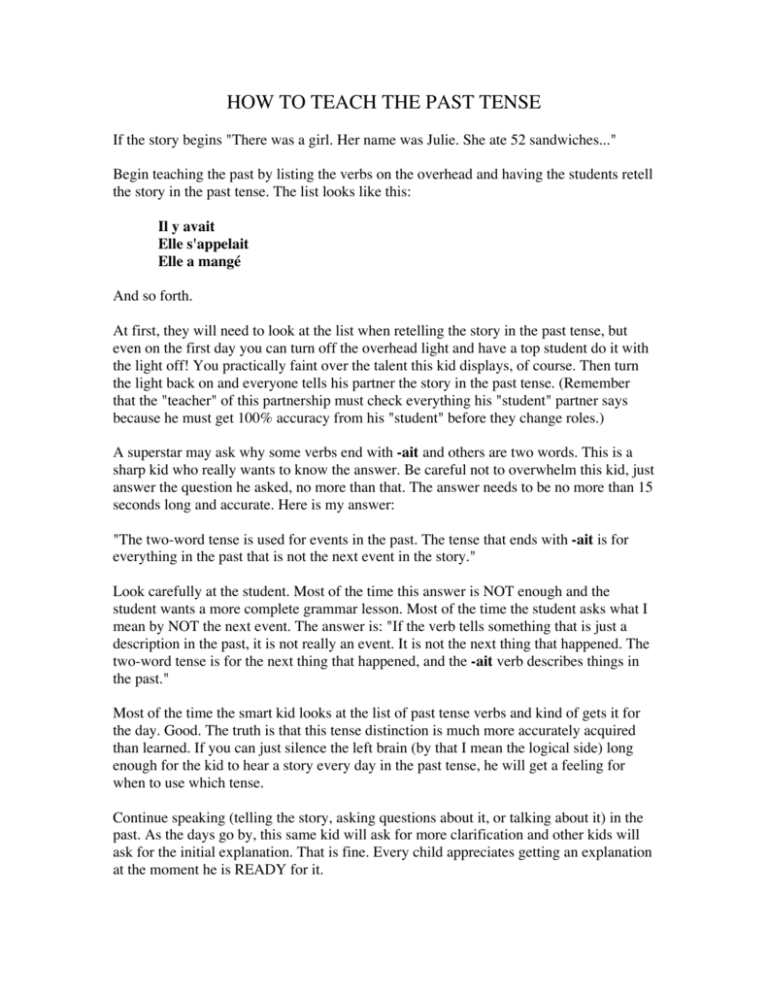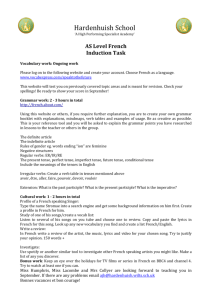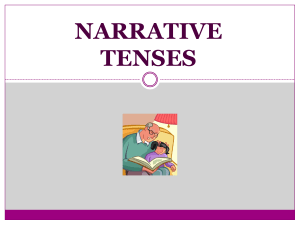how to teach the past tense
advertisement

HOW TO TEACH THE PAST TENSE If the story begins "There was a girl. Her name was Julie. She ate 52 sandwiches..." Begin teaching the past by listing the verbs on the overhead and having the students retell the story in the past tense. The list looks like this: Il y avait Elle s'appelait Elle a mangé And so forth. At first, they will need to look at the list when retelling the story in the past tense, but even on the first day you can turn off the overhead light and have a top student do it with the light off! You practically faint over the talent this kid displays, of course. Then turn the light back on and everyone tells his partner the story in the past tense. (Remember that the "teacher" of this partnership must check everything his "student" partner says because he must get 100% accuracy from his "student" before they change roles.) A superstar may ask why some verbs end with -ait and others are two words. This is a sharp kid who really wants to know the answer. Be careful not to overwhelm this kid, just answer the question he asked, no more than that. The answer needs to be no more than 15 seconds long and accurate. Here is my answer: "The two-word tense is used for events in the past. The tense that ends with -ait is for everything in the past that is not the next event in the story." Look carefully at the student. Most of the time this answer is NOT enough and the student wants a more complete grammar lesson. Most of the time the student asks what I mean by NOT the next event. The answer is: "If the verb tells something that is just a description in the past, it is not really an event. It is not the next thing that happened. The two-word tense is for the next thing that happened, and the -ait verb describes things in the past." Most of the time the smart kid looks at the list of past tense verbs and kind of gets it for the day. Good. The truth is that this tense distinction is much more accurately acquired than learned. If you can just silence the left brain (by that I mean the logical side) long enough for the kid to hear a story every day in the past tense, he will get a feeling for when to use which tense. Continue speaking (telling the story, asking questions about it, or talking about it) in the past. As the days go by, this same kid will ask for more clarification and other kids will ask for the initial explanation. That is fine. Every child appreciates getting an explanation at the moment he is READY for it. Here is an explanation of each and every verb in my example. Do NOT do this literally, but I have written it out for you to see the reason that my little grammar rule for “figuring out the past tenses” works so well. The first verb is "There was a girl." Is the existence of a girl the first event in the story? Did she come into existence at the moment this sentence is uttered or did she already exist? Is her existence the first thing that happens in the story, or does this sentence simply describe the state of affairs as the story opens? Good job, it is not an event, it just describes the state of affairs. That is why the verb ends with -ait. What about her name? Is that an event in the story or was her name already Julie before the story started? Good! If it is not an event, then it just describes her so the verb ends with -ait. What about "she ate"? Is that an event in the story or was she already eating before we got to this sentence in the story? Good! You are right. It is the first real event in the story, so it is a two-word tense. All the things that happen are two-word and all the description stuff ends in -ait. As I write this out it looks long and cumbersome. I hope that you can imagine how I am asking kids questions and guiding them to the right answer. I hope you can understand how easy it is for kids to get the feeling for the two tenses when the choice is narrowed down to "next event or not next event." Very soon in this process (like the second or third past tense story,) you can ask the kids to predict whether you will write the verb as two words or with -ait. They begin to get them right almost immediately. They think it is easy, they have no fear of the past tense, they speak and write in the past tense, and within a month of this more than half of the kids are writing original essays in the past tense. Their usage of the past tenses is pretty good, the top kids have it nailed! If you continue to do this for six months (begin with 3rd person singular, then when that is solid go to a different point of view) you will find that they really have the past tenses! And incidentally the irregulars, the possessive adjectives, the direct and indirect object pronouns all get a good workout doing this point of view retelling. -=-=-=-=-=-=-=-=-=Here is another message that is almost the same, with a Spanish example and another explanation of why this works so well: Is "her name was" the next event in the story? No? OK then it must not have the accented ó on the end. Is "She ate" the next event in the story? Yes? OK then it must have the accented ó on the end. This lesson takes less than 15 seconds. It is easy to learn because it is based on what the words MEAN in English rather than a grammar rule. (Next event vs NOT next event is MEANING; it is not grammar.) Students can learn "va" means "goes" and "mange" means "eats" because in their minds those two words have different MEANINGS. Make your 15 second past tense lesson be the same thing: vocabulary (what it MEANS in English.) If you drag out all the grammar rules (habitual action, repeated event, series of events, description, completed action in the past, state of mind, etc.) you are NOT asking the kids to base their language on meaning. The consequences are: 1. They will get confused . 2. It will take a long time for them to catch on. 3. It will turn off a huge bunch of kids. 4. Those who are turned off will drop the foreign language. If we discourage students in this way, we can never accomplish the dream of a bilingual America. On the other hand, if you simply use meaning as the underpinning of grammar, the kids get a feeling for the two tenses because they MEAN something different. Personal Testimonial: Two years ago I had 8th grade kids who wrote original stories in FRENCH in the past tense before going to the high school. Their stories were pretty good. They almost always chose the right tense without having had the "rules"-- because they had the FEELING for tenses from a couple of months of 15-second grammar lessons. (Spelling, agreement, etc were about what you would expect from 8th graders) When they got to the high school they were taught straight out of Allez Viens! They had a horrible time learning the past tenses in their high school French II class. They came to my school to visit me. They told me that the past was “hard.” This experience tells me that the "grammar explanation" method (as textbooks do it) is confusing to them. They already had a feeling for the tenses and the feeling was negated by the grammar-structure presentation.







